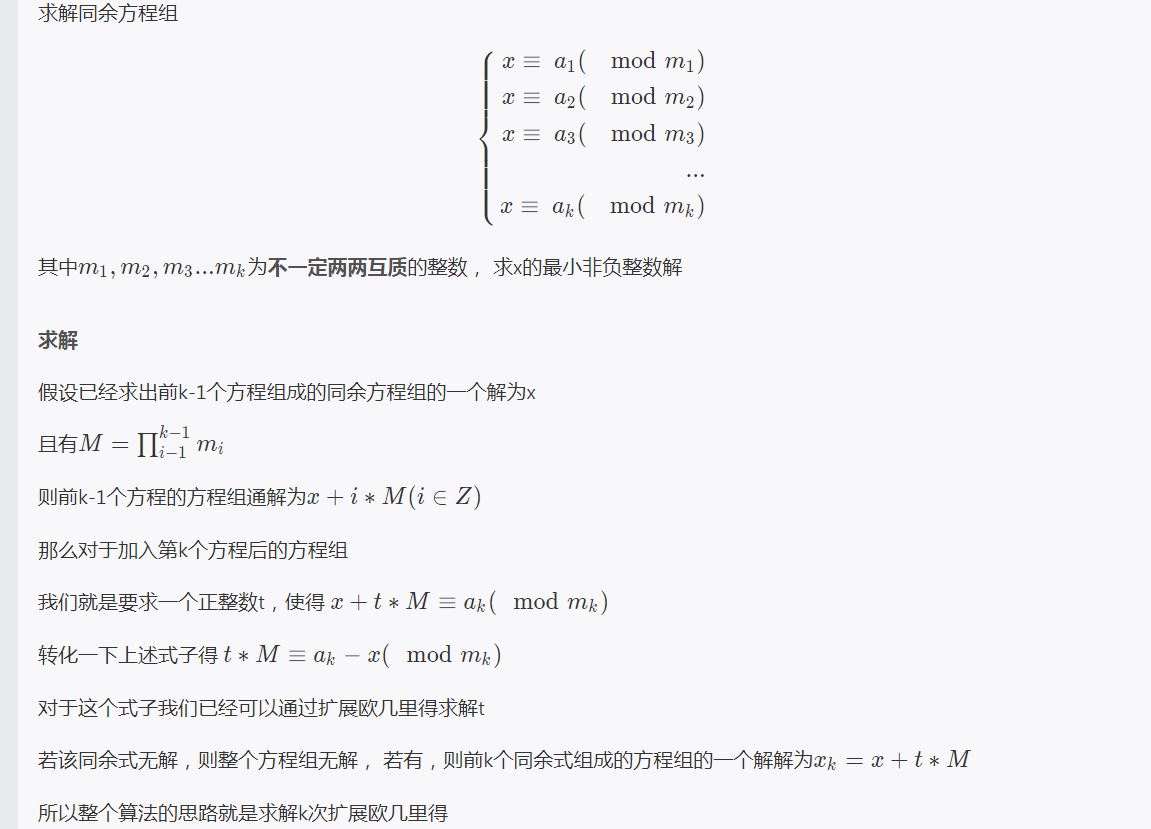我爱过你,利落干脆
复习一下EXCRT吧!

顺便贴下我以前的代码
1 | // luogu-judger-enable-o2 |
模数LCM需要小于long long范围(实在不行只能写高精度这种恶心的东西了)
顺便看下Lucas定理(又是抄袭):
卢卡斯定理
我的大部分式子都是展开形式就是一堆没有的展开
首先我们需要证明$C_p^i\equiv\frac{p}{i}C_{p-1}^{i-1}\equiv 0~~~(mod~p),(1<=i<=p-1)$
$C_p^i=\frac{p!}{i!(p-i)!}=\frac{p}{i} \frac{(p-1)!}{(i-1)!(p-1-i+1)!} \frac{p}{i} \frac{(p-1)!}{(i-1)!(p-i)!}=\frac{p}{i}C_{p-1}^{i-1}$
得证。
然后根据这种性质和二项式定理。,我们马上得出
$(1+x)^p\equiv C_p^01^p+C_p^1x^{2}+….+C_p^px^p\equiv C_p^01^px^0+C_p^p1^0x^p\equiv 1+x^p(mod ~p)$
然后我们接下来要求证
$C_a^b\equiv C_{a_0}^{b_0}\cdot C_{a_1p}^{b_1p} \cdot C_{a_2p^2}^{b_2p^2}…..(mod~p)$
其实我们令$a=lp+r,b=sp+j$好奇怪的变量名呀,随便起的~~
求证$C_a^b\equiv C_{lp}^{sp}\cdot C_{r}^{j}(mod~p)$然后利用性质递归求解就可以了。
继续从二次项定理出发
$(1+x)^a=(1+x)^{lp} \cdot (1+x)^r$
然后展开$(1+x)^{lp}$
$(1+x)^{lp} \equiv ((1+x)^p)^l \equiv (1+x^p)^l(mod~p)$
$\therefore (1+x)^a \equiv (1+x^p)^l \cdot (1+x)^r(mod~p)$
观察项$x^b$的系数
$\because C_a^bx^b \equiv C_l^sx^{sp} \cdot C_r^jx^j(mod~p)$
$\therefore C_a^bx^b \equiv C_l^s \cdot C_r^jx^b(mod~p)$
$\therefore C_a^b\equiv C_l^s\cdot C_r^j \equiv C_{\lfloor \frac{a}{p} \rfloor}^{\lfloor \frac{b}{p} \rfloor}\cdot C_{a~mod~p}^{b~mod~p}(mod~p)$
//上面的取模写法好像不大严谨,还请见谅(并没有系统的学过同余)
得证
实现的时候注意可能出现计算组合数m比n大的情况,这个时候需要返回0不然会算错
1 |
|
然后愉快的看ExLucas原理
扩展卢卡斯定理。
首先,得确定先会扩展欧几里得算法和扩展中国剩余定理。至于卢卡斯定理,那并不重要。
设$p=\prod p_i^{k_i}$,则:
假如你已经求出了$\binom{n}{m}\bmod{p_i^{k_i}}$,那么明显是可以利用exCRT来合并答案的。
那么问题转换为如何求出$\binom{n}{m}\bmod{p^k}$(p是质数)。
可以知道:$\binom{n}{m}=\frac{n!}{m!(n-m)!}$那么问题即转化为求出几个阶乘和阶乘的逆元。
现在,问题归为如何快速求出阶乘。
为了便于统计出现了多少个$p$的次幂,先将阶乘中所有p的倍数提出来。可以简单算出,一共有$\displaystyle\lfloor\frac{n}{p}\rfloor$个。这中间每一项都除去p,可以得到$\displaystyle\lfloor\frac{n}{p}\rfloor!$。该部分可以选择递归求解。
那么接下来只剩下非$p$的倍数的几项了。通过简单观察可以知道(这里很玄学),剩余几项具有循环节,循环节长度小于$p^k$。原因是剩余项关于$p$具有循环节,而$a+p^k\equiv a\pmod{p^k}$,所以可以一起计算。结果会剩下几项凑不齐一个循环节,但是这几项长度已经小于一个循环节了,可以选择暴力求解。
为了更好地理解上方几条,可以举个栗子:

这样就可以在可承受的时间复杂度内求出阶乘。但是,为了达到除法的效果,我们需要考虑$p$的次幂一共出现了多少次。根据前面的计算,可以知道只除去一个$p$时,$n!$内包括了$\displaystyle\lfloor\frac{n}{p}\rfloor$个$p!$。剩下的数字如果要可能存在$p$的次幂也可以归为一个阶乘,即$\displaystyle\lfloor\frac{n}{p}\rfloor$!。设$f(n)$表示$n!$中有多少个$p$的因数,那么,我们就可以得到一个递推式$f(n)=f(\displaystyle\lfloor\frac{n}{p}\rfloor)+\displaystyle\lfloor\frac{n}{p}\rfloor$边界为:$f(x)=0(x<p)$
开始计算时间复杂度。
首先是中国剩余定理的复杂度,是$O(plogP)$的。(其中P是模数,p是最大质因子)。
然后是求阶乘复杂度。当求$n!\bmod p^k$时,时间复杂度为$O(p^klogn(log_pn-k))$
最后是求逆元的复杂度。利用扩展欧几里得可以做到$O(logp)$
因此,总复杂度为$O(\sum p^klogn(log_pn-k)+plogP)$
这个复杂度和$O(PlogP)$同级。
献上因为写完10分钟,有个函数没开$ll$调了两小时的玄学EXLUCAS模板:
1 | // luogu-judger-enable-o2 |
在写exlucas之前我们最好学习一下CRT(中国剩余定理),这样exlucas的代码量就可以少一点。
中国剩余定理

我们如何证明它的正确性呢?
这样我们只需要看看如何通过上述定理合并两个同余方程。
1 | inline ll CRT(ll b,ll mod){return b*inv(p/mod,mod)%p*(p/mod)%p;} |
p是所有模数乘起来(就是所有mod乘起来),mod是当前模数,然后就是上面一模一样的定理。我们可以用这个在$O(logn)$的时间里合并同余方程(各模数互质)。
然后就可以补上最上面那个玄学定理(没有确定的时间复杂度和正确性保证。。)的题解代码。
简单的扩欧写法:
1 | void exgcd(LL a,LL b,LL &x,LL &y) |
数论题有的地方忘了开long long调试真是痛苦的事情。。。。
幸好debug能力变强了一点,不过还是看了2小时。。。。以后用long long就全用得了。。
总结:四个有趣的数论定理回顾了一下,EXLUCAS玄学算法无正确性证明,我还是那么菜。